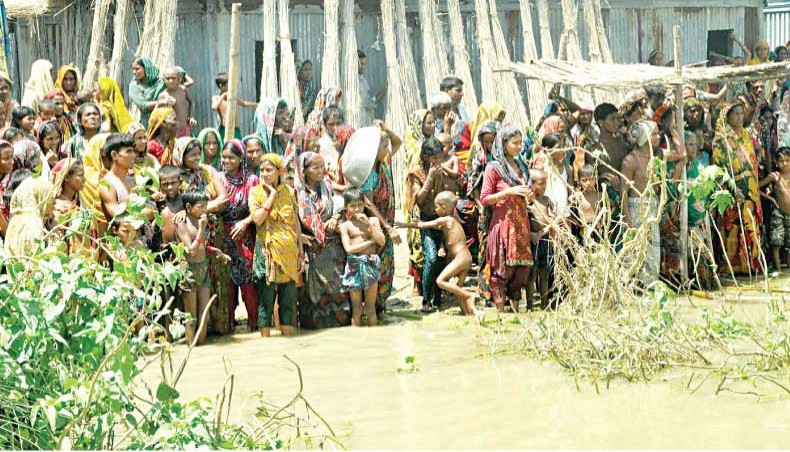Padma in central region keeps rising
The flood situation in the country’s northern region improved on Sunday, with water having started receding in major rivers.
People displaced by flood have started to return to their homes. Many flood victims are still staying under the open sky as they do not have money for rebuilding their houses damaged by the flood.
About half of the 6.5 lakh flood victims are in northern districts, according to officials.
Local government representatives in the flood-affected northern districts have alleged that most of the flood victims are facing food and drinking water crises due to inadequate relief supply.
In the central region, the Padma is still rising, devouring more homesteads in Munshiganj.
The onrush of water from upstream in India contributed to rising of rivers in north-eastern region.
‘We hope the north-eastern region will come to a steady state in the next 48 hours,’ said flood forecasting and warning centre’s duty officer Sarder Udoy Raihan.
‘The Brahmaputra and the Jamuna will continue to fall in the next 72 hours,’ he added.
‘The overall flood situation across the country is likely to improve by the end of this week,’ Sarder added.
The morning bulletin of the FFWC showed that at almost half the 13 places, where rivers were flowing above the danger level, the water level recorded falls in the last 24 hours.
Our Munshiganj correspondent reported that the Padma devoured three houses in Tongibari upazila since Sunday night.
Our Jamalpur correspondent reported that the Jamuna fell by 24 cm in the last 24 hours.
People started returning to their houses in Islampur and Dewanganj upazilas.
The upazila chairmen in both the upazilas alleged that the relief supply was far from being adequate to meet the people’s demand.
Islampur’s Chinaduli union chairman Abdus Salam said there were about 2,000 families who did not get any relief in his area.
The chairman said the authorities should ensure that there was enough supply of medicine to prevent water-borne diseases from breaking out as the people were likely to drink from sources contaminated by flood upon their return to their houses.
The medical teams working in the area was not enough should there an outbreak of diseases, he added.
According to the civil surgeon’s office, there are 77 medical teams working in the flood-affected areas in the district. An estimated 30,000 people have been affected by the flood.
The district relief and rehabilitation office said that 300 tonnes of rice, Tk 5.65 lakh and 4,000 packets of dry food were distributed among the affected people.
Our Lalmonirhat correspondent reported that relief supply did not reach most of the 63 flood-affected chars.
The affected people in the chars are not yet getting monetary assistance to start rebuilding their houses damaged by flood.
Julekha Bewa of Sinduna char in Hatibandha returned to her home eight days after she had left in the wake of the flood.
‘I don’t have any idea of how I will rebuild my home,’ said Julekha Bewa.
Our Sylhet correspondent reported that the river Kushiyara rose 19 cm and the Surma 63 cm on Sunday. The areas that surfaced following recession of water over the last week started to go under water from Saturday night again.
The BSS reported that disaster management and relief minister Mofazzal Hossain Chowdhury Maya, while visiting Gaibandha on Sunday, said the government would construct shelter centres for affected people in each union parishad of 17 flood-prone districts very soon.
A huge amount of fishes worth Tk 1.15 crore of 336 ponds in Gaibandha have been washed away due to the current flood triggered by hilly waters from the upstream, reported BSS.
The BSS also reported that erosion by the Padma at Charbagdanga union in Chapainawabganj Sadar upazila took a serious turn making at least 90 families homeless.
The UNB reported that at least 200 families lost their houses in the last two days in three upazilas of Kurigram as floodwater started to recede, triggering erosion.
News Courtesy: www.newagebd.net











